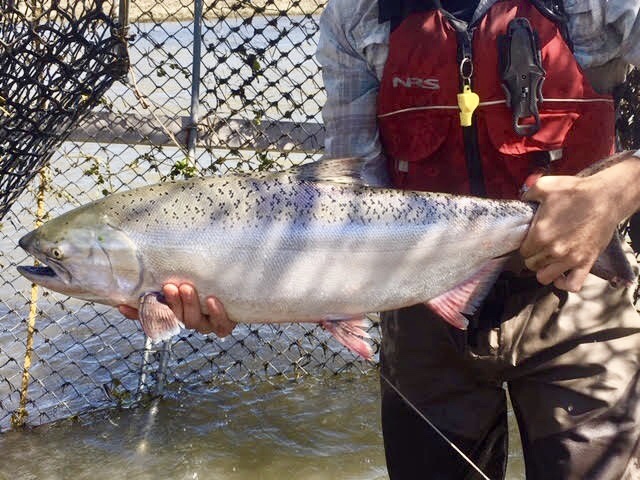After 65 Years, Spring-Run Chinook Salmon Successfully Return to the San Joaquin River
Spring-run adult Chinook salmon. Photo courtesy of USBR. 
The San Joaquin River – the second longest river in California – was once home to one of the largest populations of spring-run Chinook salmon, a species of fish that is now classified as threatened under the Endangered Species Act.
Thanks to a collaborative multi-agency effort that includes the Department of Water Resources (DWR), spring-run Chinook salmon are successfully returning to the San Joaquin River for the first time in more than 65 years.
At the end of May 2019, 23 adult spring-run Chinook returned, surviving their nearly 370-mile round trip journey to the Pacific Ocean as juvenile fish and the trip back to the San Joaquin River as adults to spawn – typically a two to five-year process.
The returned Chinook included some of the 38,000 juvenile fish spawned at the state’s Interim Salmon Conservation and Research Facility located on the banks of the San Joaquin River. The juvenile fish were released in the San Joaquin River in March 2017. Researchers can identify them by their removed adipose fins and coded wire tags.
The successful return of Chinook to the Central Valley river was made possible by the San Joaquin River Restoration Program (SJRRP), a comprehensive, long-term effort that was formed in 2007 with two major goals: 1) to achieve a naturally self-sustaining population of Chinook salmon in the San Joaquin River from the Friant Dam to the confluence of the Merced River, and 2) to mitigate water supply impacts to water users as the result of the program’s restoration flows.
The SJRRP was established as the result of a 2006 federal court agreement that settled an 18-year battle between environmentalists and federal water contractors over use of San Joaquin water below Friant Dam, part of the federal Central Valley Project. The program is supported by five agencies including DWR, U.S. Bureau of Reclamation, U.S. Fish and Wildlife Service, National Marine Fisheries Service, and the California Department of Fish and Wildlife.
"The spring-run Chinook returns this year certainly are exciting," said Donald Portz, manager of the project with Reclamation. "DWR is an integral partner in building on this success by promoting projects that increase channel capacity and fish passage."
Restoration work will also benefit other native fish species including fall-run Chinook, Pacific lamprey, steelhead trout, and white sturgeon.
DWR’s South Central Region Office, in coordination with the Bureau of Reclamation, is also conducting studies and projects that will further support successful fish passage conditions by modifying or removing structures identified as impediments, such as flood control and water diversion structures. This will provide fish with a better opportunity to complete their life cycle and spawn without human aid.
“DWR is expected to complete construction on a fish passageway on the Eastside Bypass in 2020 that will allow fish to further travel upstream, getting closer to their spawning habitat,” explained Paul Romero, Supervising Engineer with DWR’s South Central Region Office.
Currently, biologists capture and transport returning adult Chinook to spawning grounds to avoid fish from becoming trapped below barriers that impede their natural migration.
DWR is also working on other projects in support of the SJRRP including strengthening levees to allow for higher in-channel river flows, improving off-stream recreational fishing opportunities, and isolating gravel pits to reduce juvenile salmon mortality.
